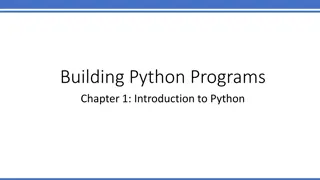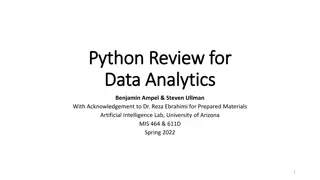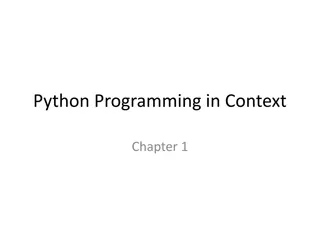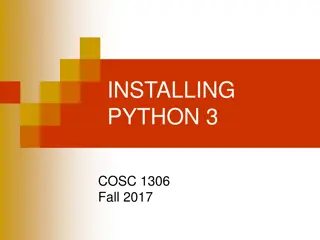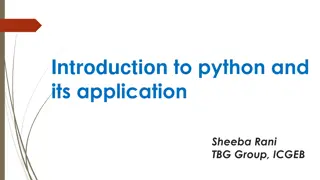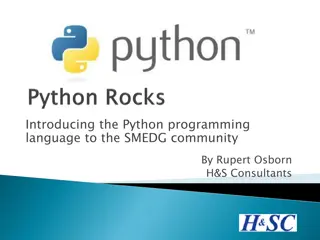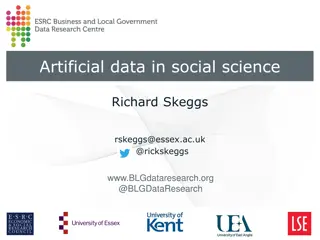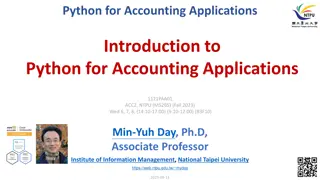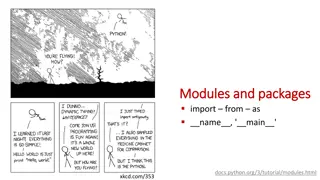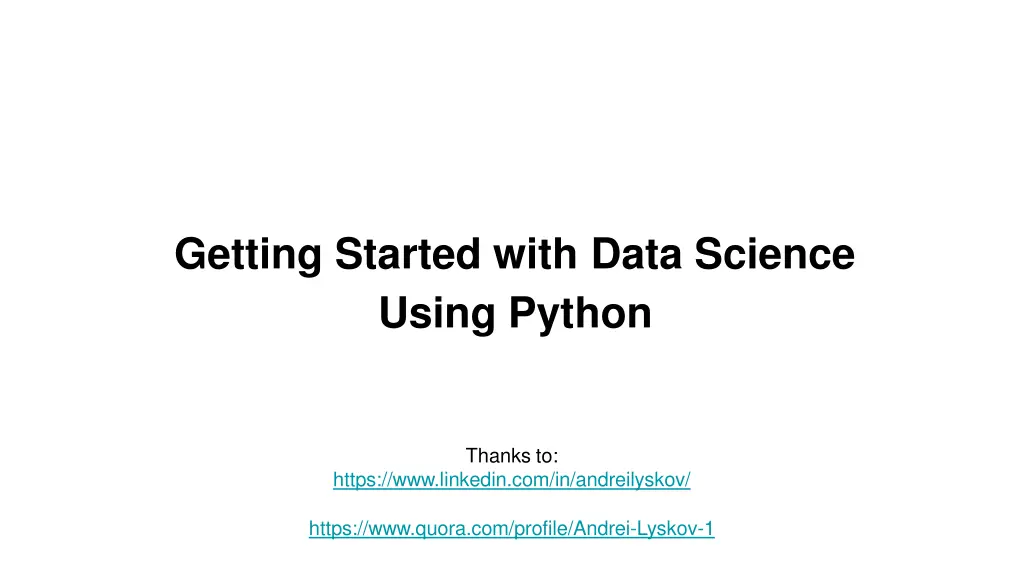
Beginner's Guide to Data Science Using Python - Step-by-Step Tutorial
Learn the fundamentals of data science with Python, covering topics such as data gathering, pre-processing, exploration, model building, validation, and deployment. Understand the key concepts and steps involved in data science, including gathering and preparing data, exploring data insights, and utilizing machine learning algorithms for analysis. Dive into the world of data science and kickstart your journey towards becoming a data scientist.
Uploaded on | 0 Views
Download Presentation

Please find below an Image/Link to download the presentation.
The content on the website is provided AS IS for your information and personal use only. It may not be sold, licensed, or shared on other websites without obtaining consent from the author. If you encounter any issues during the download, it is possible that the publisher has removed the file from their server.
You are allowed to download the files provided on this website for personal or commercial use, subject to the condition that they are used lawfully. All files are the property of their respective owners.
The content on the website is provided AS IS for your information and personal use only. It may not be sold, licensed, or shared on other websites without obtaining consent from the author.
E N D
Presentation Transcript
Getting Started with Data Science Using Python Thanks to: https://www.linkedin.com/in/andreilyskov/ https://www.quora.com/profile/Andrei-Lyskov-1
Related to Data Science Information Retrieval: The key goal of an IR system is to retrieve all the items that are relevant to a user query, while retrieving as few nonrelevant items as possible Query-document similarity. What features are relevant? How to query? Machine learning Algorithms that learn patterns in the data Under the hood of most data science approaches Data mining Data Mining is about finding the trends in a data set (mostly for human post- processing). Data Science encapsulate data mining, the distinction between DM and ML is a bit fuzzy (mostly in how are the found patterns utilized)
Data Science Steps Gather data Pre-processing Exploration phase Model building Model validation Scope of the course Model deployment
Data Science Steps Data Gathering (beyond scope of this course) [numpy, Pandas] Not too much problem at the classes, but extremely important in reality (What data do I actually want? Can I have it? How to obtain it?) 3rd party data, no unique identifier, missing data, approximate joins, updates Wikidata, DBPedia, Linked Open Data Data Preparation / pre-processing (this is where the magic comes ) [scikit-learn (numpy, Pandas)] Data cleaning, inputs for missing values, features normalization, outliers detection Features augumentation / selection / construction / reduction - Transformers (fit -> transform) - https://scikit-learn.org/stable/modules/impute.html (deal with missing values) - https://scikit-learn.org/stable/modules/generated/sklearn.preprocessing.Normalizer.html (features/objects => axis=1/0) - https://scikit-learn.org/stable/modules/generated/sklearn.decomposition.PCA.html (too many correlated features) - https://scikit-learn.org/stable/modules/feature_extraction.html (transform feature space, e.g., numeric -> Binary) - https://scikit-learn.org/stable/modules/generated/sklearn.preprocessing.PolynomialFeatures.html (feature combinations) - https://scikit-learn.org/stable/modules/generated/sklearn.preprocessing.quantile_transform.html (transform to cum. distribution)
Data Science Steps Exploration (iterates with pre-processing) [scikit-learn / matplotlib / Seaborn ] Get some insights on the data, understand its structure, create initial hypothesis Clustering algorithms, histograms, plots, correlation https://scikit-learn.org/stable/modules/clustering.html -> Agglomerative clustering https://seaborn.pydata.org/generated/seaborn.heatmap.html https://seaborn.pydata.org/generated/seaborn.pairplot.html Model Building [scikit-learn, TensorFlow, Keras, ] Random Forests, SVM s, Rule-based, Deep Learning, K-Nearest Neighbours (semi)-supervised / reinforced (dynamic model selection) / representation learning Estimators (fit -> predict) https://docs.scipy.org/doc/scipy-0.15.1/reference/generated/scipy.spatial.distance.cdist.html(distance calculations <- embeddings) https://scikit-learn.org/stable/modules/generated/sklearn.ensemble.RandomForestClassifier.html (tree-based model) https://scikit-learn.org/stable/modules/neighbors.html (K-nearest neighbors, ML basics, curse of dimensionality) https://scikit-learn.org/stable/modules/generated/sklearn.linear_model.LinearRegression.html (Linear regression , ML basics, high bias)
Data Science Steps Model Validation [scikit-learn, matplotlib, Seaborne ] Prediction accuracy, ranking correctness, Precision vs. Recall, Temporal complexity!! https://scikit-learn.org/stable/modules/model_evaluation.html Types of error (false positive vs. false negative what is more important?) Results visualization (PCA, Self-organizing maps https://github.com/JustGlowing/minisom) Results vs. Model hyperparameters -> Seaborn heatmaps Model Deployment Finally you ll deploy your model into the wild, as you gather more data and feedback on how its doing you ll be able to tweak and improve it as time goes on.
Task: Select dataset (sklearn.datasets.fetch_[dataset name]): Boston house prices dataset (price prediction from numerical data) https://scikit-learn.org/stable/datasets/index.html#boston-dataset 20 newsgroups dataset (classification based on news text) https://scikit-learn.org/stable/datasets/index.html#newsgroups-dataset Wine quality dataset (last seminar, regression) Learn some (surprising) facts about the dataset Try to predict the output variable (keep it simple KNN, linear regression ) Experiment with feature extraction / hyperparameter tuning / model selection Report results Are those tasks relevant? How would real-world tasks looks like?
Learning Data Science With Python - Libraries A free software machinelearning library that features various classification, regression and clustering algorithms including support vector machines, random forests, gradient boosting, and k-means and is designed to interoperate with the Python numerical and scientific libraries NumPy and SciPy. Pandas is a software library written for the Python programming language for data manipulation and analysis. In particular, it offers data structures and operations for manipulating numerical tables and timeseries. NumPy is a library for the Python programming language, adding support for large, multi- dimensional arrays and matrices, along with a large collection of high-level mathematical functions to operate on thesearrays.
Learning Data Science With Python - Libraries Keras is an open source neural network library written in Python. It is capable of running on top ofTensorFlow, Microsoft Cognitive Toolkit, Theano, or MXNet. It was developed with a focus on enabling fast experimentation A plotting library for the Python programming language and its numerical mathematics extension NumPy TensorFlow is an open-source software library for dataflow programming across a range of tasks. It is a symbolic math library, and is also used for machine learning applications such as neural networks.
Learning Data Science With Python - Tools Open-source web application that allows you to create and share documents that contain live code, equations, visualizations and narrative text http://jupyter.org/ Similar to Jupyter Notebook, but with the added benefit of google doc type sharing and collaboration https://colab.research.google.com Crestle is yourGPU-enabled Jupyter environment in the cloud. https://www.crestle.com/







